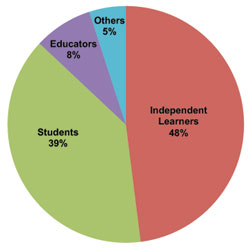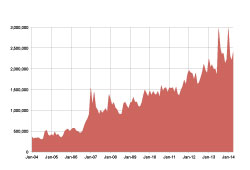
| Vol.
XXVI No.
5 May / June 2014 |
| contents |
| Printable Version |
OCW Educator: Sharing the "How" as well as
the "What" of MIT Education
What really goes on behind the scenes in designing a course at MIT? What considerations underlie the multitude of decisions leading to the material presented on OCW (OpenCourseWare) course pages? What do MIT faculty say about what worked and what didn’t?
OCW has initiated a new venture designed to pull back the curtain on these issues. Named OCW Educator, it is explicitly addressed to educators, reaching out to our colleagues at MIT and across the world to share what we can about teaching the courses we teach.
When MIT OpenCourseWare was launched back in 2001, most people expected its audience to consist primarily of educators.
Educators were considered key to the success of the site because they were seen as multipliers, adapting the MIT course material as published by OCW for their own purposes. OCW course sites were structured to be convenient for educators to use, with the course materials organized by content type rather than chronologically so instructors could quickly survey all the readings, lecture notes, or assignments, and download them at will.
But it turned out that independent learners, widely distributed around the globe, quickly became OCW’s principal audience. This audience has grown steadily over the years, and today some 48% of the three million visitors per month received by OCW are independent learners. Another 39% are students. Only eight percent are teachers.

(click on image to enlarge)
OCW has welcomed this unanticipated global recognition, and has addressed the self learner population directly through enhancements such as OCW Scholar, a family of OCW offerings that have been organized into sequential courses and augmented with much new material. But there has been a residual sense that more could be done to serve the originally envisioned audience of educators.

(click on image to enlarge)
The new OCW Educator sets about enhancing the value of OCW’s holdings by supplementing the course material with explanation, annotation, and insight. The goal is to share the “How and Why” as well as the “What” of instruction at MIT. The spirit of this project is like that of OCW in general – open sharing: MIT instructors share their personal experiences and reflections in the belief that these might prove useful to others.
Project Origins
The idea of improving the value of material already on OCW for teachers was originally put forward by Professor Hazel Sive several years ago at a meeting of OCW’s Faculty Advisory Committee, and the three of us were tasked with coming up with a proposal. Key to our proposal was the benefit to MIT’s own faculty in making it easier for instructors to learn about educational innovations going on around campus:
. . . using OCW to showcase how we teach will help spread new pedagogical ideas being generated here at MIT across MIT itself. The problem of dissemination of novel pedagogy is well-known, and OCW can very likely make this much easier.
Under the guidance of a Faculty Steering Committee and OCW Executive Director Cecilia d’Oliveira, the initial OCW Educator publication launched in 2013, and after some fine-tuning, Educator components have now begun to appear regularly in OCW courses. The Educator project manager (the person mainly responsible for getting this project off the ground) is Kathy Lin, an MIT graduate who majored in mathematics.
The Course in Context
So what is OCW Educator? Its main component is a new page on OCW course sites called This Course at MIT, which assembles background information about the teaching of the course, including:
- the instructor’s course goals
- curriculum information (prerequisites, requirements satisfied, how often the course is offered)
- classroom photos (which venues are used)
- student information (enrollment breakdown by year, major, and previous experience in the subject)
- a graphic calendar (showing what happened in each class, e.g., lecture, lab, discussion)
- how student time was spent (in and out of class)
- class assessment
- course team roles (who did what)
The page has a standard template for ease of use. This Course at MIT pages that have been published to date have been collected on a landing page on the OCW site.
| Back to top |
Instructor Insights
Many This Course at MIT pages also include a section called Instructor Insights in which the instructor shares his or her reflections on the teaching of the course – the pedagogic approach, the rationale for this approach, the evolution of the course since its inception, what’s worked best and what hasn’t.
Instructors of courses now being published on OCW are invited to fill out a survey that solicits these reflections, and many have obliged, some quite expansively, providing pages of information. For some courses, OCW conducts in-person interviews with the instructor and uses the responses to create pages describing insights and practices revealed by the questionnaire and interview.
Instructor Insights may contain text, photos, representative examples of classroom activities, and even embedded video in which the instructor explains how the course works.
OCW has already published Instructor Insights from a number of different MIT Schools and disciplines. Here are a few highlights:
- 7.013 Introductory Biology Professor Hazel Sive discusses her approach to teaching problem-solving in introductory biology, interacting with students in a large class, and interfacing with 7.00x, MITx’s online course.
- 16.06 Principles of Automatic Control Professor Steve Hall explains the benefits of getting students up on their feet actively engaged in working out problems during recitation sessions and how this method of teaching promotes deeper conceptual understanding.
- 15.S07 Global Health Lab Professor Anjali Sastry describes how she plans, teaches, and runs an intensive “action learning” course in the Sloan School of Management, in which student teams take on projects with health care delivery organizations in sub-Saharan Africa and South Asia.
- 21H.1324J Medieval Economic History in Comparative Perspective Professor Anne McCants presents her views on how she gets students to make connections and problem-solve and how she interweaves current events into her course to make the course more relevant to students’ lives.
- 4.241J Theory of City Form Professor Julian Beinart describes what it’s like to teach a legacy course taught at MIT since 1956, how the course has changed under his auspices, and how the course uses case studies of cities to generalize and create theory.
Experiential Courses
The Educator project has made it possible for OCW to serve educators in other ways. Certain courses taught at MIT do not lend themselves very well to publication on OCW in the traditional format. These may be project-based or experiential courses that do not have traditional components such as a set syllabus, lecture notes, and a textbook.
A prime example of this is 18.821 Project Laboratory in Mathematics, a course created by Professors Michael Artin and Haynes Miller. In this course, students are offered the opportunity to experience the frustration and excitement of doing mathematical research. They work in teams on projects that are open-ended and may change every time the course is offered. They write papers in a style appropriate to journals in the field, and give an oral presentation of their findings to the class.
OCW Educator afforded a way for OCW to publish this course. Instead of showing the syllabus, readings, and assignments in the manner of a standard OCW course, the course publication includes:
- Staffing the Course (how many instructors are involved, what are their roles)
- Mathematical Work (choosing productive projects for students)
- Teamwork (fostering teamwork, forming student teams)
- Writing (helping students learn to write at a professional level)
- Presentations (teaching students to be effective presenters)
The site also includes an introductory video in which the instructors explain how the course works and how they address the trickiness of guiding students in their research projects without overdirecting them, and students comment on their experience in the class. OCW hopes to represent other experiential courses in this way in the future.
Future Promise
The future holds great promise for OCW Educator as it looks to document the changes happening from the further incorporation of both active learning and digital technology into residential instruction at MIT. OCW plans to create landing pages for courses sharing a similar structure or theme, such as lab courses, capstone courses, and communication-intensive courses. The goal will be to enhance these course collections with instructor reflections and advice. OCW will soon create a Web portal that will provide resources for educators in search of materials on instruction at MIT.
Part of the intent of the OCW Educator project is to encourage discussion of pedagogical issues. Please contribute to this conversation through the project survey, which is linked at the top of every This Course at MIT page.
| Back to top | |
| Send your comments |
| home this issue archives editorial board contact us faculty website |